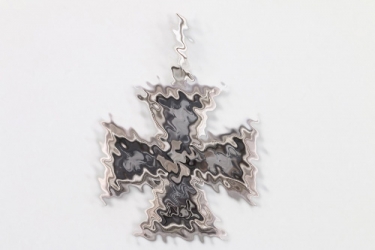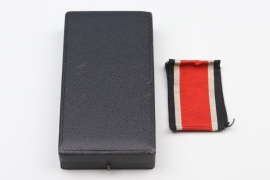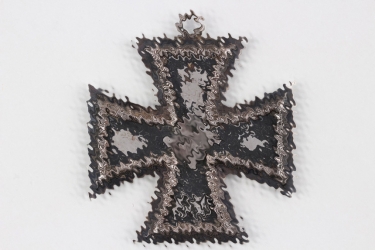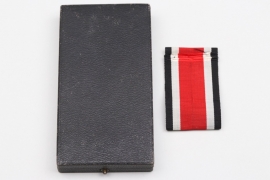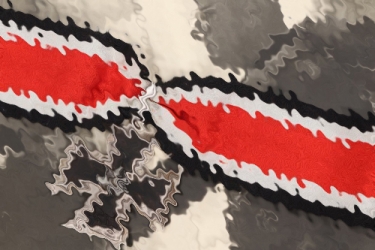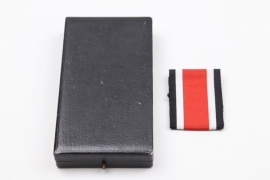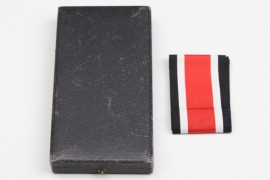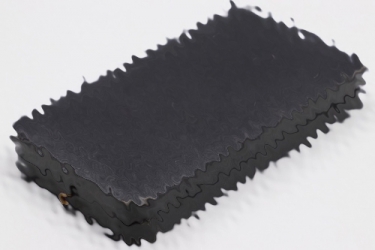Ritterkreuz des Eisernen Kreuzes
Militaria Preisdatenbank
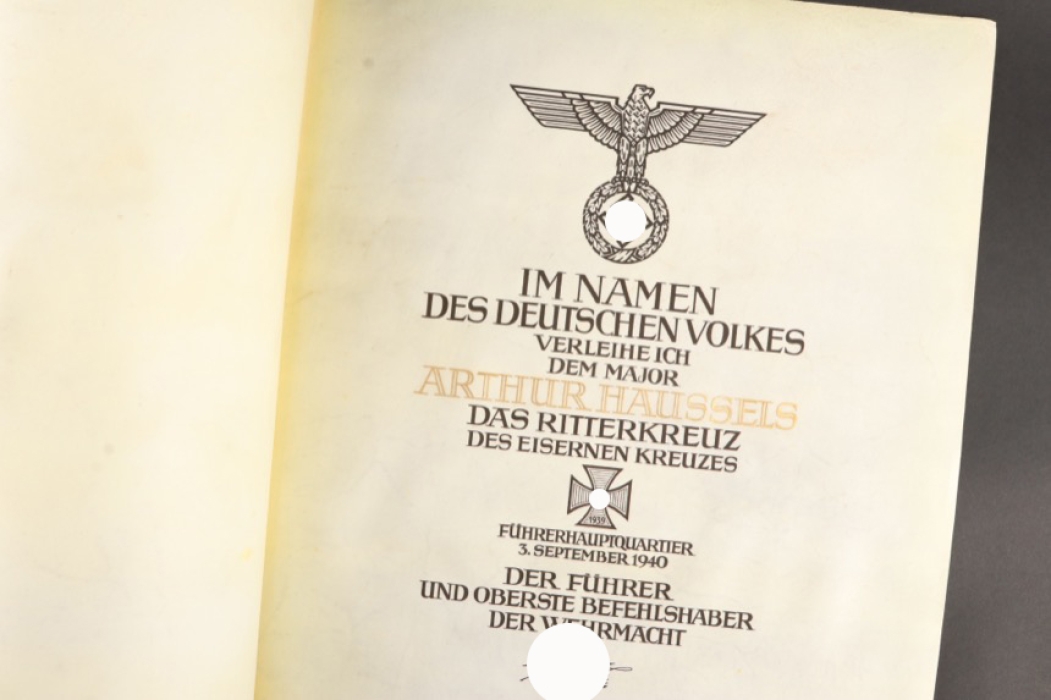
Major Arthur Haussels - Urkunde zum Ritterkreuz des Eisernen Kreuzes
MILITARIA PREISDATENBANK
Wie kann ich Verkaufspreise sehen?
Melden Sie sich noch heute unter www.ratisbons.com/de/militaria-preisdatenbank für unsere MILITARIA PREISDATENBANK an! Bei Abschluss eines jährlichen Abonnements für nur 75€ sparen Sie 25%.
Ihr Zugang zu allen Verkaufspreisen, Bildern und Beschreibungen wird umgehend nach Abschluss Ihres Abonnements freigeschaltet.
Wir kaufen Einzelstücke und ganze Sammlungen und beraten Sie auch gerne telefonisch: 08541 9053699
-
Bezahlung
-
WIE KANN ICH FÜR MEINE BESTELLUNG BEZAHLEN?
AUKTIONAlle erfolgreichen Gebote werden automatisch zu einer einzigen Bestellung zusammengefasst. Für diese können Sie uns nach Auktionsende in Ihrem persönlichen Kundenkonto Ihre bevorzugte Bezahl- und Versandart oder eine alternative Lieferadresse mitteilen.
Wenn wir diese freiwilligen Angaben nicht von Ihnen erhalten melden wir uns automatisch im Laufe des Montags nach Auktionsende mit einer Zahlungsanweisung per Email. Basierend auf Erfahrungswerten schlagen wir Ihnen die bequemste Bezahlmehtode und die günstigste Versandart vor. Sie möchten Ihre Bezahl- und Versandart ändern oder eine alternative Lieferadresse angeben? Kein Problem! Besuchen Sie Kundenkonto/BESTELLUNGEN oder kontaktieren Sie uns per Email.
BESTELLUNGEN IM ONLINESHOPWählen Sie während der Bestellung Ihre bevorzugte Bezahl- und Versandart und schicken Sie diese ab. Sie erhalten Ihre Zahlungsanweisung spätestens am darauffolgenden Tag per Email. Die Zahlungsfrist beträgt sieben Tage. Sie planen eine Bestellung per Ratenzahlung zu begleichen? Bitte sprechen Sie uns gerne vor Ihrer Bestellung darauf an.
Für mehr Informationen zu Bezahlung und Versand, besuchen Sie unsere Häufigen Fragen.
WIR AKZEPTIEREN FOLGENDE BEZAHLARTEN
-
-
Versand
-
IHRE BESTELLUNG IN DEN BESTEN HÄNDEN
VERPACKUNG & SENDUNGSVERFOLGUNGNach Zahlungseingang versenden wir Ihre Bestellung für gewöhnlich am darauffolgenden Werktag. Wir bestätigen den Eingang Ihrer Zahlung per Email und informieren Sie zur Versandvorbereitung. Nach Abholung der Sendung durch unsere Versanddienstleister teilen wir Ihnen die Sendungsnummer per Email mit. Den Status Ihrer Sendung können Sie auch jederzeit unter Kundenkonto/BESTELLUNGEN einsehen. Ihre Rechnung geht Ihnen automatisch am Tag des Versands zu.
VERSAND ZU EINER ALTERNATIVEN ADRESSEBevorzugen Sie für eine Bestellung einen Versand zu Ihrer Arbeitsstelle? Sie sind im Urlaub und wünschen den Versand zu einer Packstation oder einem Freund? Kein Problem! Diese Änderungen können Sie jederzeit unter Kundenkonto/BESTELLUNGEN vornehmen. Alternativ können Sie natürlich jederzeit auch per Email informieren.
UNSERE PARTNER FÜR DEN VERSAND
-
-
Garantie
-
 GARANTIE!
GARANTIE!Alle angebotenen Artikel werden von unseren Experten akribisch auf deren Echtheit geprüft und detailiert beschrieben. Wir bieten ausschließen zeitgenössiche Originale an. Etwa 15% aller Kundeneinlieferungen ensprechen unseren Anforderungen nicht und werden retourniert.
Gekauft wie gesehen? Nicht bei uns. Im Gegensatz zu traditionellen Auktionshäusern bieten wir volles Rückgaberecht of Originalität an. Sollten Sie mit Ihrer Bestellung nicht zufrieden sein, können Sie die Bestellung innerhalb 14 Tagen widerrufen. Bitte kontaktieren Sie uns vor dem Rückversand. Für mehr Einzelheiten besuchen Sie bitte unsere häufigen Fragen.
In eigener Sache: Bieten Sie nur auf Lose, die Sie auch erwerben möchten. Bitte vermeiden Sie Gebote nach Auktionende zu stornieren. Sollten Sie ein fehlerhaftes Gebot abgegeben haben, informieren Sie uns bitte umgehend. Wir löschen Ihre Gebote gerne bis 24 Stunden vor Ende der Auktion.
-
Land Deutsches Reich 1918 - 1945
Maße 43.8 x 35.5 cm
Gewicht
 US Los 62-0004
US Los 62-0004EAN 3000000016152
 US Los 62-0004
US Los 62-0004Epoche 1918 — 1945
Land Deutsches Reich 1918 - 1945
Land Deutsches Reich 1918 - 1945
 US Los 62-0004
US Los 62-0004Deutsches Reich 1918 - 1945
Ritterkreuz des Eisernen Kreuzes
Beschreibung
Major Arthur Haussels (February 4, 1895 – February 13, 1943)
Major Arthur Haussels was the battalion commander (II./Gebirgs-Jäger-Regiment 139/3. Mountain Division) Haussels proved himself in the operation "Weserübung" and in the Battle of Narvik. In March 1942 he took over command of the regiment as successor to Alois Windisch. In 1943, Lieutenant Colonel Haussels commanded the 756 Mountain Jaeger Regiment, which was set up in December 1942. On January 18, 1943, the operation "Eilbote" began under the command of the 334th Infantry Division under Major General Friedrich Weber. His mountain troops flew with Jus 52 from Naples to North Africa. His men conquered the Djebel Solbia mountains and later (under Holzinger) the Djebel Mansour in north-east Tunisia. In this battle, the mountain infantry was defeated by soldiers of the Foreign Legion. "You fought like lions" said a captured foreign legionnaire of German origin after the fight. In February 1943, while in the hospital, Haussels was promoted to colonel for bravery in the face of the enemy.
"[...] I myself flew to North Africa on January 18, 1943, with about 10 men, an infantry gun, 2 field kitchens and various equipment. The group of planes consisted of about 50 machines and flew towards Sicily at a height of about 50 m above the sea. As we approached, we saw another group of Ju 52s circling over Palermo, which then joined our formation. After landing at Tunis airfield, we were overwhelmed by the enthusiasm of our Luftwaffe comrades astonished when unloading, but soon we realized from a pile of wrecked planes that we couldn't overlook that we really had to hurry. Since the German transport planes, for some inexplicable reason, left Naples at the same time as the train at 5 or 6 a.m., the enemy fighter pilots were able to score plenty of kills over the Bay of Tunis. We were lucky that day and were not bothered. 2 days later the planes that had just landed were bombed and the airfield looked as if it had been sprinkled with confetti. The 'confetti' was all the mail for the 5th Panzer Army in Tunisia. At the end of January 1943, a whole group was shot down over the Mediterranean Sea and not a single machine arrived in Tunis. Around January 25, 1943, the Geb.Jäg.Rgt. 756 was detached from the divisional formation and formed an independent combat group with Panzer Battalion 501, equipped with new Tiger tanks, which was used in the sector of a badly battered Italian division. The task of the combat group was to set up an HKL in the mountains to the west and thus for the Africa Army under Field Marshal Rommel arriving from Libya in southern Tunisia to keep their back free. Heavy fighting broke out again and again with the retreating French troops, whose artillery shot very well and who were already being strongly supported by British units. There was particularly fierce fighting around the Djebel Mansour, from which the entire plain with the roads between Medjes Lel Bab and Pont du Fahs southwest of Tunis could be seen. Since the weak Italian garrison could not hold the mountain, we had to fight for the summit of Djebel Mansour three times. In the last attack more than half of the company, platoon and squad leaders were wounded or died. The Allies had established by mid-February a reasonably closed front in the western part of Tunisia and the fighting was intensifying. Our Rgt.Kdr. colonel Haussels was seriously wounded and died shortly afterwards in a hospital in Naples." — Gregor Seidenschwarz, With the Mountain Jaeger Regiment 756 in Africa (Tunisia), in: "The Mountain Troops - Journal of the Comrades' Circle of the Mountain Troops"
The regiment was destroyed in Tunisia in May 1943, the bulk of the team that was operational up to then was captured by the US Americans and distributed to various camps in the US
Haussels, who was fighting at the front line, urging his fighters on with the words "Let's go Jaga!", suffered a shot in the leg during the first combat mission in the Tunis bridgehead, as a result of which he (after treatment at the main dressing station and in the hospital in Tunis) was flown out and in the hospital in Italy died after leg amputation. (From metapedia.org)
Knights Cross of the Iron Cross formal award document issued to Major Arthur Haussels on parchment with an integral blank front leaf, Führerhauptquartier, September 3, 1940. The ornately lettered document is executed in India ink and gold with a hand-inked signature of Adolf Hitler at the bottom. The parchment is just the slightest bit wavy, as is very common in such documents, but otherwise fine condition. Award documents for the Knight’s Cross are rare, even though Hitler granted over 7,000 of them. A severe backlog soon developed and, in the end, very few recipients of the award ever received their large formal award documents.
The document is part of a veteran bring-back that we proudly offer here for the very first time. The GI opted to bring 9 single formal documents in one red presentation leather folder (Mappe) which will be auctioned with Ratisbon’s through a couple of auctions.
Zustand
1-
Verkäufer
History Trader Inc., 521 Thorn Street #165, Sewickly, PA 15143-0165, USA
NAME
Ritterkreuz des Eisernen Kreuzes
DATUM DER STIFTUNG
1. September 1939 als dritte und neue Stufe des wiederhergestellten Ordens vom Eisernen Kreuz
AUSZEICHNUNGSKRITERIEN
Das Ritterkreuz des Eisernen Kreuzes wurde für besondere Tapferkeit im Angesicht des Feindes und für heraus- ragende Verdienste um die Truppenführung verliehen. Die Verleihung des Ritterkreuzes erforderte die vorherige Vergabe der beiden niedrigeren Stufen. Das Ritterkreuz wurde allein vom Führer auf Vorschlag der Einheit des Soldaten verliehen und vom Heerespersonalamt ausgestellt. Die Ritterkreuze wurden in der Ordenskanzlei in Berlin aufbewahrt, um nach Genehmigung dem Beliehenen zugeschickt zu werden. Vor Ende April 1945 wurden auf keiner Ebene der Wehrmacht Ritterkreuze gelagert.
HERSTELLER
Das Ritterkreuz des Eisernen Kreuzes wurde von sieben Herstellern gefertigt, Varianten innerhalb den einzel- nen Firmen nicht berücksichtigt. Die Ritterkreuze findet man entweder ungestempelt (frühe Juncker und 3/4 Ring Kreuz), mit Silbergehaltsstempel, mit einer LDO-Nummer (L/12 und L/52) und später mit der Präsidialkanzlei- Nummer des Herstellers (2, 20, 65 und 4). Privatverkauf war ab Oktober 1941 verboten.
VERLEIHUNGSZAHLEN
Genaue Zahlen sind nicht bekannt, aber die Schätzungen liegen bei 7.200 und ein paar hundert mehr auf Laager bei der Präsidialkaanzlei.
AUSZEICHNUNGSUNTERLAGEN
Der Beliehene erhielt eine vorläufige Urkunde im Format A5, ausgestellt im Namen des Führers von den zustän- digen Personalämtern der drei Wehrmachtsteile. Die formellen Urkunden (Große Mappe) wurden später aus- gestellt und sind aufgrund des großen Herstellungsrückstandes nur mit Datum Ende 1942/Anfang 1943 zu finden.
TRAGEMETHODE
Das Ritterkreuz wurde mit dem rot/weiß/schwarzen Band als Halsorden getragen. Das Ritterkrreuz wurde im schwarzem Etui und beiliegendem Band verliehen.




